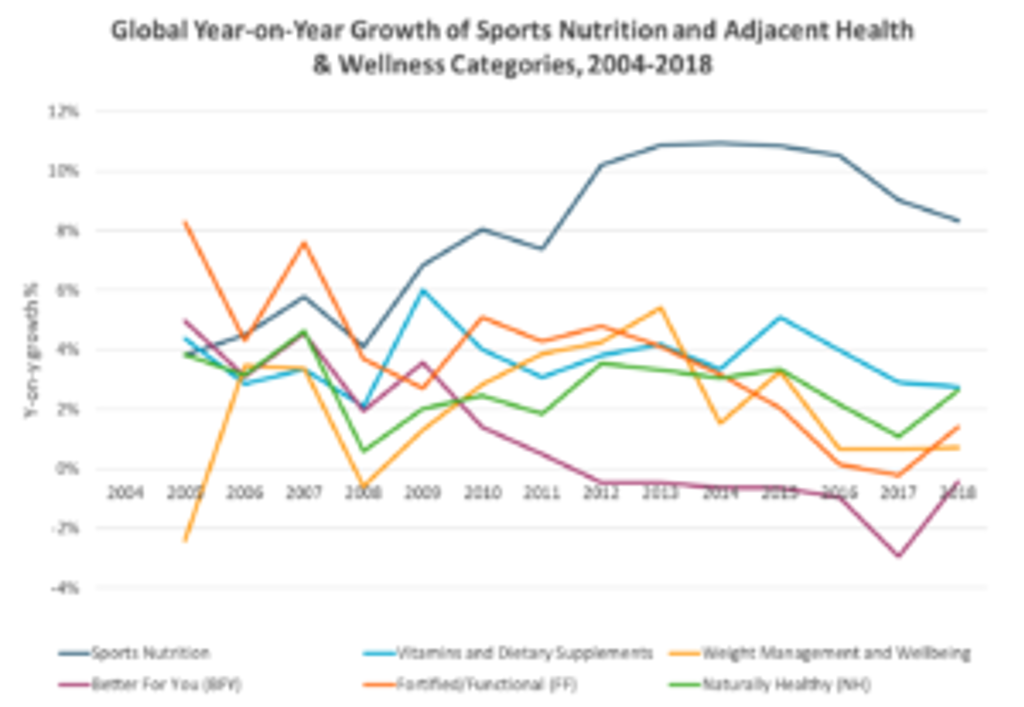The sports nutrition industry is amidst a long-term growth trend unparalleled in recent consumer health history. From 2004 to 2018, the global sports nutrition market grew 190% at a compound annual growth rate (CAGR) of 7.9%, according to Euromonitor International. Such high growth for that long is unprecedented in fast-moving consumer goods. Fads and new product developments can stir consumer interest for a handful of years, but even the broadest trends mature and show flattening growth over the long term.
Newer consumers to the category have broader demands for sports nutrition: weight loss, fighting age-related ailments like sarcopenia, or vegans and vegetarians looking to supplement their diet. There’s also the broad swath of consumers with nebulous health, nutrition or lifestyle goals who want to live healthy and active lifestyles but aren’t interested in performance goals per se.
The mix of sports nutrition products is expanding to meet the demands of these new consumer groups. Healthy nutrition advocates are drawn less to the traditional offer of whey-based protein and instead opting for fitness-oriented products like plant protein powders, nodding toward a slimming or clean-label orientation or on-the-go snack-based options like sports protein bars and ready-to-drink (RTD) sports protein.
The expansion to new consumer groups, positionings and an overall wider health focus has put sports nutrition in direct competition with the broader nutritional products universe, which include healthy consumables across packaged goods like health and wellness foods, vitamins and dietary supplements, and weight management and wellbeing products that are used to meet consumers’ nutritional and health goals.
Newer adopters of sports nutrition are viewing these products as an extension of the larger nutritional purchases they make to meet their daily lifestyle goals. At the same time, product launches and ingredient innovations in healthy snacking have pushed the much larger nutritional space in the direction of sports nutrition as well.

Source: Euromonitor International
Increased interest in protein as a functional ingredient has created direct competition from the health and nutrition marketplace increasingly saturated by protein products. Most legacy food and drink companies have introduced a protein-fortified extension to tie their brand to the protein halo, especially within the snacking universe. As newer sports nutrition evangelists demonstrate, meeting consumers’ insatiable appetite for protein can come in several forms.
Though these products have performance and exercise benefits, many times they are marketed as better-for-you snacks. Protein launches are popping up all over the grocery aisle, and given the broad positioning of protein, it is increasingly unclear how these products should be consumed. Are they purely for functional/healthier snacking? Can consumers swap these products in before, during or after a workout? This intentional blurring means that some consumers will use these products for both purposes.
As mainstream consumers are more amenable to purchasing sports nutrition products, companies in the space are extending their distribution to mass channels that historically have shown limited interest in sports nutrition. Given the on-the-go functionality of sports protein bars and sports protein RTDs, these products have easily made the jump to smaller mass-oriented channels like convenience stores and forecourt retailers in the US, with a similar push occurring in other principal markets like the UK and Australia. At the same time, these retail channels are undergoing a transformation from stocking only quick, on-the-go snacks to a broad mix of healthy living and lifestyle brands.
Sports nutrition is expected to outpace the broader set of nutritionals through 2023 at an 8% global CAGR, compared to less than 3% CAGR for other adjacent nutritional categories, according to Euromonitor International. Sports nutrition sits in a valuable position, as the category builds from performance and exercise goals into wellness and lifestyle positioning as necessary. Euromonitor International expects sports nutrition to cross the US$20 billion threshold in 2021 globally and reach US$23 billion in 2023.
However, strong growth is predicated on continued innovations keeping sports nutrition at arm’s length from the broader mainstream nutritionals space. Though the number of core users continues to expand, especially in emerging markets, the category needs other consumer groups outside core users to sustain the growth the industry has come to rely on this decade. As a result, much of the innovations expected to guide category growth in the future will come from extending offerings to broader consumer groups rather than retrenching around core functionalities.
The full version of this article originally appeared in the April issue of Nutritional Outlook.
